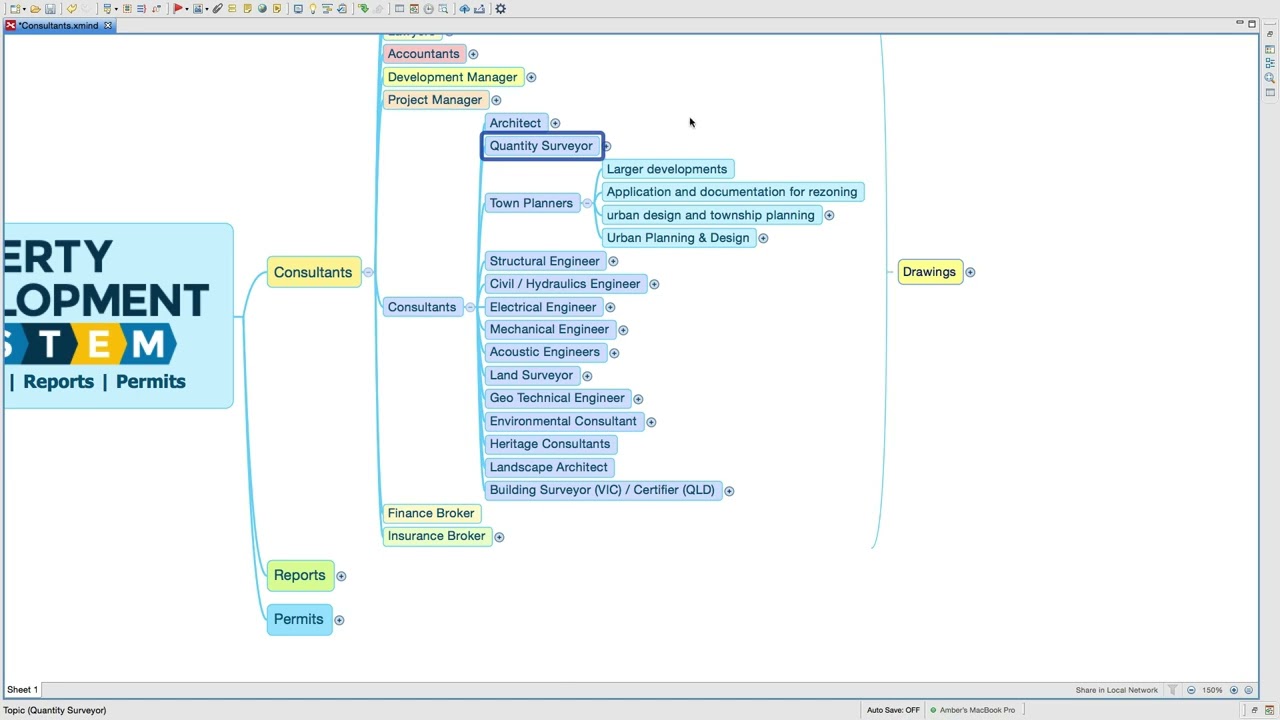Consultants Part 2
Consultants Part 2
You will uncover the roles and responsibilities of various consultants involved in architectural and construction projects.
Architects
Assist with design, architectural feasibility (determining what can be built on a plot), and can recommend other consultants. They are involved in preparing conceptual sketches, working drawings, and managing the project, including site visits and cost estimates.
Quantity Surveyors
Essential for larger projects and whenever borrowing from banks. They evaluate construction costs and verify progress claims, ensuring that the financial aspects of the project align with the planned budget.
Town Planners
Necessary for larger projects to handle applications and documentation for rezoning, urban design, and township planning. They work closely with architects for smaller projects, but specialised firms may be required for complex initiatives.
Structural Engineers
Collaborate with architects to ensure structural integrity through detailed shop drawings for concrete and steel elements, structural stability evaluations, and on-site supervision.
Insights based on numbers
- The consultation process can significantly affect project costs, with various specialists bringing their expertise to ensure compliance, efficiency, and financial viability.
- The detailed involvement of these professionals emphasises the complexity and multidisciplinary nature of construction projects, highlighting the importance of careful planning and budgeting.
Frequently Asked Questions
How do architects contribute to cost estimation and project management?
Architects play a crucial role in both cost estimation and project management for construction and development projects. Their contributions are multifaceted:
Design and Feasibility
Architects initially help with the design process and conduct architectural feasibility studies.
These studies are critical for understanding what can be built on a plot, which directly influences the project’s cost and feasibility. By assessing the potential of a site (e.g., for apartments or townhouses), architects lay the groundwork for project viability.
Conceptual and Working Drawings
Through the preparation of conceptual sketches and detailed working drawings, architects define the scope and specifications of a project.
These documents are essential for accurate cost estimation, as they detail the materials, dimensions, and construction techniques to be used.
Project Management
Architects often take on the role of project managers, overseeing the project from conception to completion. This includes conducting site visits, managing the project timeline, and liaising with other consultants and contractors. Their oversight ensures that the project adheres to the planned budget and timeline.
Cost Estimates and Feasibility Studies
Part of an architect’s job involves providing cost estimates and conducting feasibility studies. These estimates are crucial for setting budgets and making financial decisions. Architects assess various cost factors, including materials, labor, and compliance requirements, to provide a comprehensive cost overview.
Liaison with Other Consultants
Architects also recommend and work closely with other consultants, such as structural engineers and quantity surveyors, to ensure that all aspects of the project are aligned and within budget. Their coordination role is key to preventing cost overruns and ensuring that the project’s financial aspects are carefully managed.
What role do quantity surveyors play in securing loans for construction projects?
Quantity surveyors are pivotal in the financial aspects of construction projects, especially when it comes to securing loans from banks. Their involvement typically unfolds in two critical stages:
Initial Loan Application
When applying for a construction loan, the bank requires a detailed breakdown of the construction costs. Quantity surveyors prepare this cost analysis, which includes all expenses related to the project. This detailed submission is crucial for the bank’s assessment of the loan application, as it ensures that the projected costs are realistic and thoroughly accounted for.
Loan Drawdown Process
Before the release of funds during the construction phase, banks employ quantity surveyors to verify the progress claims made by the borrower. This step is essential for the bank to ensure that the loan funds are being used appropriately and that the construction progress aligns with the initial cost estimates and timelines.
The quantity surveyor’s evaluation serves as a checkpoint, preventing financial mismanagement and ensuring that the project adheres to its budget.
Moreover, the costs incurred for the services of quantity surveyors become part of the overall project expenses. This inclusion underlines the importance of factoring in these professional fees when planning the project’s financials.
In what ways do town planners and structural engineers impact the feasibility and execution of large-scale construction projects?
Town planners and structural engineers significantly influence both the feasibility and execution of large-scale construction projects in several key ways:
Town Planners:
Applications and Documentation
They handle complex applications and documentation needed for rezoning, urban design, and township planning. Their expertise is crucial for navigating the regulatory landscape, ensuring that projects comply with local zoning laws and urban design guidelines.
Urban Design and Township Planning
For larger projects, town planners develop comprehensive plans that address the broader impact of the development on the community and the environment. They work to harmonise the project with existing urban infrastructure, optimising land use and contributing to sustainable development.
Project Feasibility
The involvement of town planners from the early stages of a project ensures that any potential regulatory hurdles are identified and addressed. This proactive approach helps in assessing the project’s overall feasibility, preventing costly delays or modifications later in the process.
Structural Engineers:
Structural Integrity
They ensure the structural integrity of a project, creating detailed drawings and specifications for concrete and steel elements. This work is critical for the safety and longevity of the structure.
On-Site Supervision
Structural engineers often oversee construction work to ensure that the building process adheres to the specified technical requirements. Their on-site presence ensures that any potential issues with the structural design are promptly addressed.
Evaluation and Reporting
They conduct evaluations and provide reports on the structural stability of the project. This aspect of their work is vital for identifying and mitigating risks, ensuring that the construction meets all safety standards.
What is the role of architects in construction projects?
Architects assist with the design and architectural feasibility of a project, which involves determining what can be built on a given plot of land. They recommend other necessary consultants, prepare conceptual sketches and working drawings, and manage the project. This includes conducting site visits and providing cost estimates to ensure the project stays on track and within budget.
What are the responsibilities of town planners in construction projects?
Town planners are involved in larger projects that require applications and documentation for rezoning, urban design, and township planning. They work closely with architects on smaller projects but may require specialized firms for complex or large-scale initiatives. Their expertise is crucial in navigating the legal and regulatory framework surrounding construction projects.
In what ways do structural engineers collaborate with architects?
Structural engineers ensure that the architectural designs maintain structural integrity. They produce detailed shop drawings for concrete and steel elements, evaluate structural stability, and provide on-site supervision during construction. Their collaboration with architects is vital for the safety and durability of the structure.
How does the consultation process affect project costs?
The consultation process involves various specialists, each bringing their expertise to ensure compliance, efficiency, and financial viability of a project. The detailed involvement of these professionals can significantly affect project costs, underscoring the importance of careful planning and budgeting to keep expenses aligned with financial projections.
Why is careful planning and budgeting important in construction projects?
Careful planning and budgeting are important because they help in managing the complex and multidisciplinary nature of construction projects. By involving various consultants and professionals, projects can achieve compliance with regulations, maintain financial viability, and ensure efficiency in execution. Proper planning also helps in avoiding cost overruns and ensures that the project is completed within the stipulated time frame and budget.
Test Your Knowledge
Multiple-Choice Questions on Consultants in Architectural and Construction Projects
1. What is the primary role of architects in construction projects?
A) To provide legal advice
B) To assist with design and determine architectural feasibility
C) To handle the financial management of the project
D) To supervise construction workers directly
2. Quantity Surveyors are most essential for:
A) Small, residential projects
B) Landscape architecture
C) Larger projects and situations involving bank financing
D) Providing legal counsel on construction matters
3. The involvement of town planners is crucial when:
A) Choosing interior design elements
B) Handling applications for rezoning and urban design
C) Preparing conceptual sketches
D) Conducting on-site supervision of construction
4. How do structural engineers contribute to the safety and durability of a construction project?
A) By evaluating the project’s financial viability
B) Through creating marketing strategies
C) By ensuring structural integrity with detailed shop drawings and evaluations
D) By designing the project’s landscape
5. Which statement best reflects the impact of the consultation process on project costs?
A) It has minimal impact as consultants are rarely involved in large projects.
B) It significantly affects project costs due to the involvement of various specialists.
C) It reduces project costs by simplifying the construction process.
D) It increases project duration but has no effect on costs.
6. Careful planning and budgeting in construction projects are important because:
A) They allow for unlimited project scopes.
B) They help manage the complex and multidisciplinary nature of these projects.
C) They eliminate the need for consultants.
D) They guarantee a project’s success without the need for professional advice.
Answers
- B) To assist with design and determine architectural feasibility
- C) Larger projects and situations involving bank financing
- B) Handling applications for rezoning and urban design
- C) By ensuring structural integrity with detailed shop drawings and evaluations
- B) It significantly affects project costs due to the involvement of various specialists.
- B) They help manage the complex and multidisciplinary nature of these projects.
Assignment
Understanding the Roles of Consultants in Architectural and Construction Projects
Objective:
To deepen understanding of the roles and responsibilities of consultants involved in architectural and construction projects, through practical exercises and research.
Instructions:
Complete the following tasks, ensuring to incorporate learnings from the article on consultants in architectural and construction projects. This assignment is designed to encourage critical thinking and application of knowledge in real-world scenarios.
Part 1: Scenario Analysis
Design Proposal:
- Task: Imagine you are an architect tasked with designing a small community center on a specific plot of land.
- To Do: Create a simple sketch of your design. List the architectural feasibility considerations you must take into account for this plot.
Budget Planning:
- Task: Consider that your design proposal has been accepted, and you must now plan the budget.
- To Do: Outline the steps you would take to estimate the project costs. How would you involve a Quantity Surveyor at this stage?
Regulatory Compliance:
- Task: Your project needs rezoning and must comply with urban design standards.
- To Do: Draft a plan outlining how you would involve a Town Planner to ensure your project meets the necessary requirements.
Structural Integrity:
- Task: To ensure the safety and durability of the community center, structural integrity must be assessed.
- To Do: Describe how you would collaborate with a Structural Engineer to integrate structural stability into your design.
Part 2: Research Questions
Consultants’ Impact on Project Cost:
- Research Question: Investigate how the involvement of various consultants (like Quantity Surveyors and Structural Engineers) can impact the overall costs of a construction project. Provide examples from real projects to support your findings.
The Role of Technology in Consultation:
- Research Question: Explore how technology is used by architects, quantity surveyors, town planners, and structural engineers to improve efficiency, accuracy, and collaboration in construction projects.
Part 3: Reflection
- To Do: Reflect on the multidisciplinary nature of construction projects and the importance of each consultant’s role. How do these roles interconnect to ensure the project’s success, from design to completion? Write a brief essay (300-500 words) on your insights.
Submission Guidelines:
- Complete all tasks listed in Parts 1, 2, and 3.
- For the design proposal, sketches do not need to be professional but should convey your idea clearly.
- Research findings should be cited properly, indicating sources.
- The reflection essay should be concise, highlighting your understanding of the material and its application in real-world scenarios.
- Submit your assignment via mail or comment.



